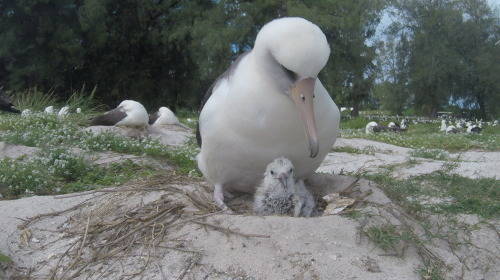World’s oldest known wild bird is a mother again on Midway Atoll

COURTESY BOB PEYTON / USFWS
Wisdoms mate, Akeakamai, watched over the new albatross chick this week at Midway Atoll. Wisdom, estimated to be 68 years old, hatched the chick over the past week.

COURTESY MADALYN RILEY /USFWS
Wisdom incubated her egg in December.


Wisdom, the world’s oldest known wild bird, has hatched another chick at Midway Atoll National Wildlife Refuge.
The Laysan albatross supermom is at least 68 years old, according to U.S. Fish and Wildlife Service officials, and has given birth to and raised at least 31 chicks in her lifetime.
Wildlife officials spotted Wisdom at her nest site at Midway on Nov. 29, where she soon laid an egg. The chick hatched at the beginning of the month, according to the Fish and Wildlife Service.
“She’s incredibly powerful as a symbol of why we do what we do and why people all over the world pay attention to her,” said Beth Flint, a Fish and Wildlife Service biologist, in a news release. “Wisdom is rewriting history about our understanding of survivorship, how long birds live, and how often they breed.”
Laysan albatrosses mate for life and lay only one egg per year. Since 2006, Wisdom and her mate, Akeakamai, have returned to Midway Atoll at Papahanaumokuakea Marine National Monument to lay and hatch an egg.
After the egg is laid, the albatross parents spend about seven months incubating it. They take turns, with one incubating the egg while the other forages for food. After another five to six months, the chicks fledge, or fly out to sea, where they spend most of their lives soaring over the ocean and feeding on squid and fish eggs.
Don't miss out on what's happening!
Stay in touch with breaking news, as it happens, conveniently in your email inbox. It's FREE!
About 3 million seabirds nest at Midway Atoll, including about a million albatrosses, which return to where they were born each year to nest and raise their young, a behavior known as “nest-site fidelity,” according to the Fish and Wildlife Service. In 2017 one of the chicks that Wisdom gave birth to was observed just a few feet away, marking the first time a returning chick of hers had been documented.
“Midway Atoll’s habitat doesn’t just contain millions of birds, it contains countless generations and families of albatrosses,” said Kelly Goodale, Fish and Wildlife Service Refuge biologist, in an email. “If you can imagine when Wisdom returns home she is likely surrounded by what were once her chicks and potentially their chicks.”
Wisdom was first banded as an adult in 1956 by biologist Chandler Robbins, who was studying the colony at Midway.
The Fish and Wildlife Service also noted that an endangered short-tailed albatross chick has been born to a pair named George and Geraldine who nested on Midway Atoll. “Short-tailed albatross’ rarity and size make them stick out in the colony, making it easier to follow them and their interactions with each other,” said Goodale.
Also for the first time, two Laysan albatross chicks hatched at Kahuku Point at the beginning of the month Opens in a new tab. Scientists and conservation groups there are working to establish a new bird colony. The majority of Laysan albatrosses nest at Papahanaumokuakea, but due to the threats posed by sea-level rise, conservation groups want to establish new colonies in the main Hawaiian Islands.



